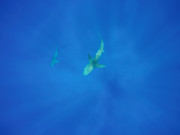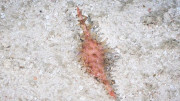Research
These short articles highlight the findings from ongoing scientific research within selected Marine Parks, including exciting new discoveries and ideas for future projects. If you are a scientist, read about how you can see your work featured in the Atlas.
Published on 13 December 2022

Small and/or camouflaged fish species hidden on or near the reef surface are commonly referred to as ‘cryptic’ or ‘cryptobenthic’ fishes. These species are characteristically difficult to see but are diverse and abundant throughout Australian Marine Parks and may play an important role in supporting the larger predatory fish species protected within park boundaries.
Published on 13 December 2022

Parks Australia manage 60 Australian Marine Parks, many of which include shallow reefs. These reef habitats are hugely diverse, and include tropical reefs dominated by hard corals; current-swept offshore bommies covered in sea whips, sea fans and soft corals; temperate rocky reefs with sea urchin barrens or low lying colourful seaweeds; and deeper rocky reefs with sessile invertebrates and large black coral trees.
Published on 13 December 2022

In this project multibeam bathymetry and baited remote underwater videos (Stereo-BRUVs) were used to characterise where reefs occur in the Hunter Marine Park and what lives on them.
Published on 7 December 2022

The 2016 and 2020 marine heatwaves each impacted shallow coral reef biodiversity in the Coral Sea Marine Park in very different ways, but the net impacts of both affected reefs in the entire region.
Published on 7 December 2022

Surveys of shallow reef biodiversity were undertaken in the Norfolk Marine Park (NMP) in 2009, 2013 and 2021 by collaborative dive teams from the Reef Life Survey program and University of Tasmania. While the reef life differed between locations around the Island, relatively little change has occurred over the 13-year study period.
Published on 26 October 2022

Scientists provide insight into the movements of the Galapagos sharks around Lord Howe Island.
Published on 1 September 2022

Mesophotic Coral Ecosystems, which typically exist between 30-150m depth, represent an unexplored but important part of our marine environment. We undertook extensive surveys of the mesophotic zone of Ashmore Reef to better understand the diversity and distribution of marine communities around the reef and help inform future management of this iconic and isolated marine ecosystem.
Published on 4 October 2021

As ocean temperatures continue to rise, a pressing challenge is to increase our understanding of the spatial distribution and characteristics of the critical habitats that support mesophotic reefs and associated demersal fish assemblages. Lord Howe Marine Park in the Tasman Sea protects the southern-most mesophotic coral reefs in the world, including Elizabeth and Middleton Reefs.
Published on 22 February 2021

Over the last decade scientists at the Institute of Marine and Antarctic Studies (IMAS) have been using an autonomous underwater vehicle (AUV) to conduct photographic surveys of seafloor (benthic) communities in Australian Marine Parks (AMPs) across the South-east Marine Parks Network (the SE Network). This project used this imagery to provide the first description of the biological communities across these marine parks and how they have changed over time.
Published on 27 January 2021
Environmental-economic accounting (EEA) is a powerful tool that enables policy and investment decisions to be made based on whole system analysis which integrates environmental, economic and social data.
A pilot accounting project was undertaken for Geographe Marine Park. The EEA examined the location and condition of ecosystems, such as rocky reefs and seagrasses, and the value of ecosystem services, like commercial and recreational fishing and tourism.
